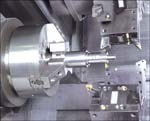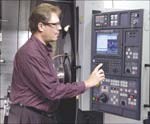Vertical Integration Reduces Cycle Times
In the fast-paced marketplace, manufacturers may feel the pressure to shorten turnaround times without compromising quality. This shop has enacted a strategy that has allowed it to provide shorter turnaround times and also to become more adaptive to its customers' needs.
Share




In the fast-paced marketplace, manufacturers may feel the pressure to shorten turnaround times without compromising quality. Crown Equipment Corporation (New Bremen, Ohio) has enacted a strategy that has allowed it to provide shorter turnaround times and also to become more adaptive to its customers' needs.
Founded in 1945, Crown originally produced temperature controls for coal furnaces. The company shifted its focus to manufacturing lift trucks in 1957. As part of a continuing effort to better its products and processes, the company has pursued the vertical integration strategy.
"Some companies are basically assemblers, ordering parts, putting them together and then selling a product," says Bill Solarek, Crown's manager of advanced manufacturing engineering. "However, we rely on an innovative workforce to determine the most appropriate way to machine our parts. We have discovered the advantages of internally producing the parts we need."
In an effort to ensure that high-quality parts go into its lift trucks, the company invests in what it considers to be "top of the line" machinery. As such, Crown has implemented a number of mills, lathes and machining centers from Mori Seiki (Irving, Texas) in its facilities.
Using vertical integration, the company can modify schedules to enable machining a single part if necessary.
"If a customer is in dire need of a product, it's a matter of rearranging our schedule to meet that requirement," explains Greg Bruns, manager of manufacturing services at Crown. "We're able to offer flexibility in our products that would be impossible if we were relying on outside suppliers. It could also prove difficult to achieve this level of service when receiving standard parts from a supplier."
While this business strategy offers various advantages, the company has found that it also presents a range of challenges. One of these challenges is finding enough skilled labor.
"Our level of integration requires that we seek highly talented personnel," says Mr. Solarek. "Given the apparent labor shortage in the manufacturing industry, one response is to take advantage of technology, automate whenever possible and take the labor hours out of your parts."
The company cites multitask machining as a factor in reducing labor for machining a range of parts. Switching to multitask machining may seem daunting at first, as the programming is more challenging than on traditional machining centers. After Crown purchased multitask machines in the ZT line, Mori Seiki sent engineers to provide critical training for running the new machines.
"The training the company provided was invaluable," says Mr. Bruns. "Once you overcome the initial challenges, multitask machining simplifies things. Parts that once required four or five operations can now be run in one setup. This can reduce material handling, the need to manage inventories of parts in-process and the actual machining time on a part. It also minimizes non-value added activities, stretching our labor further."
Previously, a rod piston machined out of 4140 pre-heat-treated steel had to pass through five machines before it was finished. The total machining time was almost 19 minutes. Using the shop's ZT2500Y, a machining time of 2 minutes and 35 seconds was achieved, a reduction of 87 percent.
A shaft found in the hydraulic cylinder pack of a lift truck, also machined from 4140 pre-heat-treated steel, used to require milling, drilling and turning operations for a total of 9 minutes. Implementing multitask machining, again with the ZT2500Y, reduced the cycle time by 72 percent, to 2 minutes and 30 seconds.
"Our industry has shifted to shorter turnaround times," says Mr. Solarek. "As a vertically integrated company, we don't have to demand shorter turnaround times from suppliers. We can invest in the technology and then work on our processes."
"Using the NH5000 HMCs, cycle times have been reduced by about 25 to 30 percent, when compared to the previous model," remarks Mr. Bruns. "This has been achieved without changing the programs."
Having experienced increased efficiency and growth, Crown continues its quest for improvement. The company has implemented Mori Seiki's Caps-Net software to help manage operations.
This software is said to facilitate the flow of information to and from the factory floor, allowing constant monitoring of machine status and operational history. The company says it uses the software to identify previously undetected inefficiencies.
"The software helps us manage the complexity of our production," explains Mr. Bruns. "For instance, by examining the reports Caps-Net generates, we identified a bottleneck where a machine was operating below optimal levels. When the software brought this to our attention, closer examination revealed that we were using the wrong density of filter for the coolant being used."
Read Next
Building Out a Foundation for Student Machinists
Autodesk and Haas have teamed up to produce an introductory course for students that covers the basics of CAD, CAM and CNC while providing them with a portfolio part.
Read More5 Rules of Thumb for Buying CNC Machine Tools
Use these tips to carefully plan your machine tool purchases and to avoid regretting your decision later.
Read MoreRegistration Now Open for the Precision Machining Technology Show (PMTS) 2025
The precision machining industry’s premier event returns to Cleveland, OH, April 1-3.
Read More



















.jpg;maxWidth=300;quality=90)













